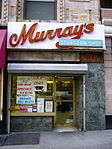Congregation Shaare Zedek (Manhattan)
1837 establishments in New York (state)Conservative synagogues in New York CityNeoclassical synagoguesReligious organizations established in 1837Synagogues completed in 1923 ... and 2 more
Synagogues in ManhattanUpper West Side

Congregation Shaare Zedek (Gates of Righteousness) is a Conservative synagogue located on West 93rd Street in Manhattan. On July 27, 2017, despite the efforts of preservationists to save it, a New York State Supreme Court judge approved the sale of the building to a developer who planned to tear it down and build a 14-story condominium.
Excerpt from the Wikipedia article Congregation Shaare Zedek (Manhattan) (License: CC BY-SA 3.0, Authors, Images).Congregation Shaare Zedek (Manhattan)
West 91st Street, New York Manhattan
Geographical coordinates (GPS) Address Nearby Places Show on map
Geographical coordinates (GPS)
| Latitude | Longitude |
|---|---|
| N 40.790888888889 ° | E -73.973222222222 ° |
Address
West 91st Street 210
10025 New York, Manhattan
New York, United States
Open on Google Maps






